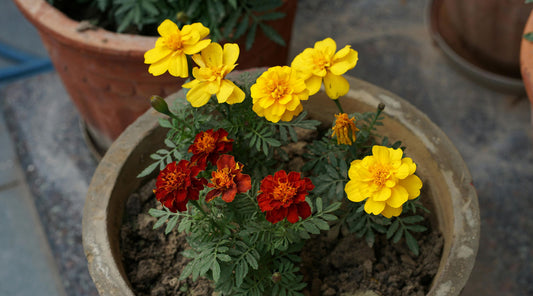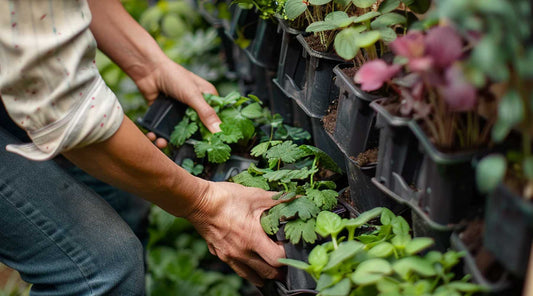So your want to garden, but don’t have a sprawling backyard to fill with veggies, flowers, and fruit? Container gardens offer an easy alternative to large plots of soil, and you can still grow virtually anything your heart desires. Yes, even trees! The key is to find the best sorts of plants for your climate and sun levels. Have a little balcony with lots of natural sun? Grow some tomatoes! Or maybe you have a patio that is often encased in the shade, try a vibrant caladium which thrives in low light. Whatever your container garden questions or needs, we’re going to hopefully cover them here.
How to Pick a Container
Sometimes the easiest thing to do is pick the pot that looks the best or is even the cheapest. While you definitely don’t need a container that will break the bank, it is important to consider different factors or you’ll have very unhappy plants.
First and foremost, your container needs to have proper drainage. Look for a pot with about four 3/8 to 5/8 inch holes in the bottom. You don’t want the hole so big that soil is escaping, but much smaller and you’re going to risk your drainage holes getting blocked by a piece of bark or rock. If you skip this step, your plants will drown and what kind of sociopath wants to be a plant killer? If you find a pot that fits your aesthetic to a T but lacks the all-important holes, have no fear. You can always drill some holes yourself, just be careful not to crack the container, in other words, take it slow.
Now that you know about adequate drainage, let’s talk about materials. The two most common pot types are terra cotta and plastic. Both have pros and cons so let’s break it down.

Terra cotta is reminiscent of our childhoods, reading Peter Rabbit and immediately craving homegrown carrots. It has a classic look and there are reasons farmers and gardeners alike have been using these pots for decades. Clay is extremely porous, and as such allows for excess moisture to escape and provides airflow to the roots (which is good!). If you’re going to be watering consistently, or even overwatering, terra cotta is great. If you’re underwatering, the terra cotta is going to dry out the plant even faster. If you know you have a busy schedule and may occasionally be a negligent plant parent, stay away from clay.
Terra cotta is much hardier than plastic and can withstand a bit more abuse. Again, this can be good or bad. Good because you can use the pot for years and years, bad because carrying that thing around is tough! If you live on the third story of your apartment and have to climb the stairs with your new pots, you might regret buying terra cotta. Plastic, on the other hand, is easily moved, which is great for chasing the sun with your plants, moving, repotting, etc. Unfortunately, lightweight also means fragile. Your plastic pots are much more likely to break, discolor, and wear down. They’re also on the cheaper side, so when one breaks it’s not going to also break the bank to replace. If you’re anything like us at Yard Butler, sustainability is super important so look for recycled plastic and try to take care of your pots so that you’re not replacing them every season.
Obviously there are more than two types of pots and containers, so let’s quickly go over a couple. A great alternative to a standard pot is one made of fabric. Companies like Smart Pots sell these types of containers and they’re especially great for vegetables. They’re also super lightweight, and most importantly breathable which allows for optimal drainage. The downside to these is that they’re not the most attractive, but if you’re looking for functionality over fashion, they’re a great choice. Ceramic is another option and basically combines the qualities of a plastic and clay pot. And lastly, if you can put soil in it you can plant in it. If you want to get creative and save some money, repurpose a household item into a planter. A drawer, a shoe, or a bread box can all serve your needs as long as they have proper drainage.
Now that you’ve found a container with good drainage in the material that suits you, how do you know which size to choose? The answer to this question is going to be different for each plant. For example, herbs and annuals only need room for about 1.5 gallons of soil (along with the plant itself). Veggies, on the other hand, are much needier and require room for about 5 gallons of soil. This also goes for perennials and generally larger plants. So you have a little baby tomato plant and are looking for a container for it. Obviously you want that baby tomato to grow up into a well-balanced adult, so don’t buy it a tiny container! Plan for growth and buy a container that will suit the adult version of your plant. There is some controversy here because a large container can hold too much moisture for your baby plant, but it’s way easier (and cheaper) than repotting constantly. Just make sure that you’re watering the right amount and not drowning your little angel.
How to Water your Container Garden
One disadvantage of a container garden is that it’s much easier to overwater your plants than when you plant directly into the ground. If you’ve followed the above directions, then you have a container with plenty of drainage and are already setting yourself up for watering success. Like most things in gardening, different plants are going to thrive with different treatment. Hearty, juicy vegetables like tomatoes want a lot of water, and succulents need to be on the drier side. When you buy your plant, check that handy little tag and it should tell you the moisture levels your plant likes. If it doesn’t, Google is your best friend!
With containers, you can get a good sense of the moisture levels in your plant by sticking your finger in the soil. If you feel moisture at your middle knuckle, that’s more of a moderate level, if you feel dry soil all the way down your finger, your plant most likely needs some water. If you can see the top of the soil is wet, then give that water a chance to absorb. Again, this really varies from plant to plant so ask your local nursery or look it up on Google.
Another important thing to consider when watering your plant is where and when. The answer to where is at the base of the plant. Avoid getting excess water on the leaves and foliage, as that can promote rot and even sunburn, and they have yet to make sunscreen for plants. As for the “when” it’s best to water your plants in the morning so that the moisture has a chance to absorb into the soil. If you are frequently watering at night, your plant may end up sitting in excess moisture until the next day.
How to Pick Potting Mix and Fertilizer
When walking through the garden center, the sheer amount of potting mixes can be overwhelming. One thing you can do to immediately limit the options is to opt for an organic mix. Organic is great for your plants because it won’t contain any harmful materials that the inorganic mixes tend to have. Additionally, you want to pick a mix for your particular plant. Vegetables need different nutrients than succulents, succulents need different nutrients than flowers, etc. As far as brands go, there is usually one that is brought up again and again by home gardeners: FoxFarm. If you can’t find that specific brand at your local nursery, you can order it on Amazon or stick to your standard Miracle-Gro but be warned it’s been hit or miss for most gardeners.
Once you’ve picked your ideal mix, you may want to consider fertilizing. Timing is super important here; you don’t want to fertilize too early or too late. Wait until your plant is to about 3/4 adulthood, and then pick an organic fertilizer. Chemical fertilizers such as Miracle-Gro are heavily concentrated and more likely to burn your plants. An organic option like Dr. Earth is good for not only your plants but the soil as well. If you have the time, energy, and space, compost is king. Even in small space gardening, you can easily hide a small compost bin under the sink in the kitchen.
Now that you have the basics, you’ll be a gardener in no time!
Share your new container gardens on Yard Butler’s Facebook page!







